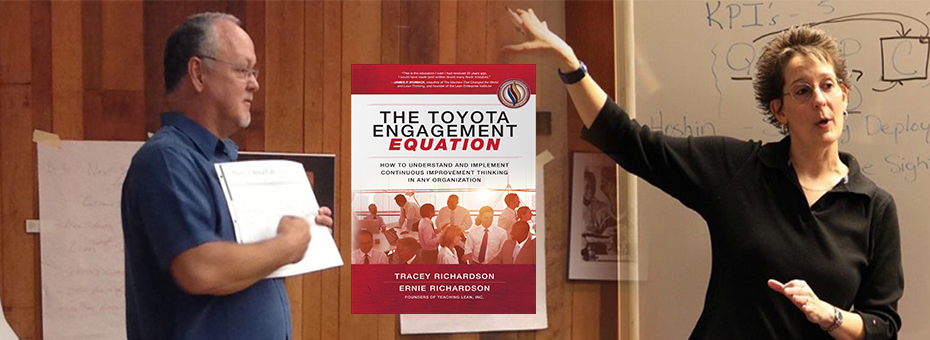One of the toughest questions I am asked by Lean newcomers is: what book should I start with? I generally cite a few select titles: Lean Thinking and The Machine That Changed the World by Jim Womack and Dan Jones are certainly canonical works; Taichi Ohno’s Toyota Production System covers the key ideas of the system he helped pioneer. John Shook’s Managing to Learn captures the essential dynamic of A3 thinking/learning, and I’m partial to any of the three Lean novels (The Gold Mine, The Lean Manager, Lead with Respect) by Michael and Freddy Ballé.
Tracey and Ernie Richardson have added a terrific book to this core selection with their late-2017 The Toyota Engagement Equation, which promises to help “understand and implement continuous thinking in any organization.” This married couple are well-known Lean teachers who learned from experience at Toyota and today write frequently, lead workshops, and otherwise spread the Lean word.
Their popular book does a great job aligning the way they share their knowledge (explaining HOW they learned WHAT they know) with the core message of Lean learning (reflect on actual work and distill wisdom from you have closely observed). Split into essentially two parts, the first half shares Tracey’s direct experience of leading and learning at the Toyota factory in Georgetown, Kentucky (where she met Ernie), and the second elaborates on the thinking system they learned on the job.
Readers learn how to train a critical eye on the immediate work in front of them and develop a structured method of improvement. Tracey and Ernie don’t hit you over the head telling you what to do or how to think per se; instead they share how they learned what they know, and in so doing, invite you to think along the same lines. They are simultaneously humble and masterful, gradually revealing the arc of their learning journey while taking time to highlight key teaching points.
The main idea is presented right up front: “If you look at the Toyota Production System simplistically, it’s about making problems and improvement opportunities visible to workers and management, and addressing them as close to the source as possible,” the authors state, adding what may be an even more important message: “The idea was that people should always be learning and improving their thinking as they go, but at the same time developing others.”
The authors gradually introduce tangible methods by which Toyota builds the most intangible of assets: a healthy culture of organizational learning and people development. They suggest that “this culture has, in our view, two pillars—the discipline to follow a path of continuous problem-solving and self-improvement, and accountability to work standards, fellow team members, company goals, and the customer experience.”
The book is packed with nuggets of wisdom. In discussing the challenge of blending the technical with the social (addressed by John Shook here), Tracey shares her thoughts on this delicate balance: “As I see it, the key is understanding the difference between the people side of Lean and the tool side. The people side will always be the most difficult aspect—here you need the discipline to create this thing called culture. The tools are just what they are, mostly countermeasures to change some discrepancy in our process. For the tools to be successful, people must understand their involvement or the purpose behind the tools.”
After grounding the story in Tracey’s 1988 hiring and her introduction to Toyota’s practices, the first section of the book unfolds in a sequence of ideas as much as it moves forward in time. One of the first of these ideas concerns standards. The definition of standards, and more importantly, the purpose of developing and revising standards, occurs early and serves as a foundational idea for creating a respectful culture of mindfulness and improvement: “If we all understand the ‘why’ behind the standards and ‘own’ the processes, we don’t have to be told what to do by our leaders, and they can spend their time developing us so that we get even better at improving the processes and the standards.”
Tracey and Ernie explain that the discipline of identifying and codifying standards helps individuals to develop an active and critical eye towards every aspect of their work, builds in mindfulness and ensures the consistent execution of the best-known way (at the time!) to create value. And creates a baseline for improvement. They remind us that standards are “a deeply ingrained idea at Toyota that standards are something all workers are committed to, whether it’s showing up for work exactly on time, or any of the other standards that we have to maintain every day.”
The first half of the book grounds the learning process through a wonderfully personal lens (without ever being gossip-y or sentimental), revealing how most aha’s are generated at the gemba through discipline, coaching, and respectful support. Tracey discusses how she was encouraged by the system and the people in it to become a leader, learning such lessons as how to lead daily standup meetings and how to coach people so that they would become less dependent on her help.
The second half of the book (comprised of two parts) unpacks the elements of the Toyota thinking system they learned, using an acronym of DNA as shorthand for discipline and accountability. These two qualities are the heart of the system, although they note that also includes “teamwork, respect, safety, standards, and a commitment to always improving your work processes.”
The authors pair DNA with two other elements: GTS6plus E3. The first refers to six categories of GTS (Go to See, Grasp the Situation, Get to Solution, Get to Standardization, Get to Sustainability, Get to Stretch); the second captures Everybody Everyday Engaged. The ensuing chapters elaborate these ideas clearly, continuing to persuade by sharing personal learning examples.
This book has much to offer for not just the newcomer to Lean, but anyone on the Lean path seeking to improve their ability to improve.
(The author of this review has edited several of the books that are mentioned—Managing to Learn,The Gold Mine,The Lean Manager, and Lead with Respect. He has also edited many articles by Tracey and Ernie that have been published by LEI, but was not involved with this book.)






